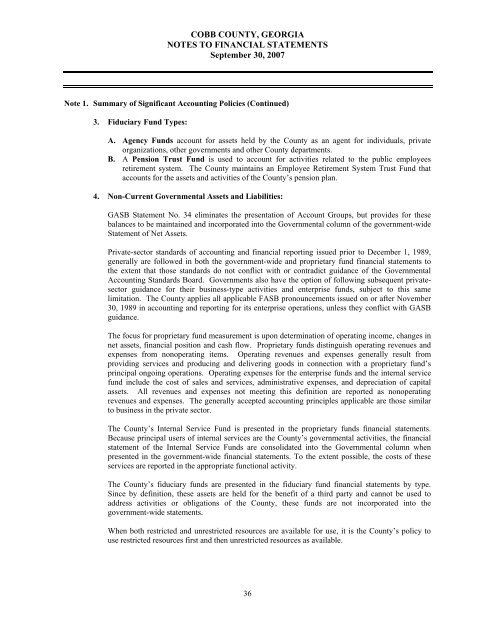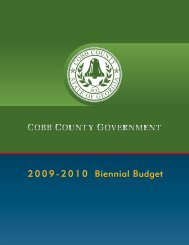Comprehensive Annual Financial Report - Cobb County
Comprehensive Annual Financial Report - Cobb County
Comprehensive Annual Financial Report - Cobb County
You also want an ePaper? Increase the reach of your titles
YUMPU automatically turns print PDFs into web optimized ePapers that Google loves.
COBB COUNTY, GEORGIA<br />
NOTES TO FINANCIAL STATEMENTS<br />
September 30, 2007<br />
Note 1. Summary of Significant Accounting Policies (Continued)<br />
3. Fiduciary Fund Types:<br />
A. Agency Funds account for assets held by the <strong>County</strong> as an agent for individuals, private<br />
organizations, other governments and other <strong>County</strong> departments.<br />
B. A Pension Trust Fund is used to account for activities related to the public employees<br />
retirement system. The <strong>County</strong> maintains an Employee Retirement System Trust Fund that<br />
accounts for the assets and activities of the <strong>County</strong>’s pension plan.<br />
4. Non-Current Governmental Assets and Liabilities:<br />
GASB Statement No. 34 eliminates the presentation of Account Groups, but provides for these<br />
balances to be maintained and incorporated into the Governmental column of the government-wide<br />
Statement of Net Assets.<br />
Private-sector standards of accounting and financial reporting issued prior to December 1, 1989,<br />
generally are followed in both the government-wide and proprietary fund financial statements to<br />
the extent that those standards do not conflict with or contradict guidance of the Governmental<br />
Accounting Standards Board. Governments also have the option of following subsequent privatesector<br />
guidance for their business-type activities and enterprise funds, subject to this same<br />
limitation. The <strong>County</strong> applies all applicable FASB pronouncements issued on or after November<br />
30, 1989 in accounting and reporting for its enterprise operations, unless they conflict with GASB<br />
guidance.<br />
The focus for proprietary fund measurement is upon determination of operating income, changes in<br />
net assets, financial position and cash flow. Proprietary funds distinguish operating revenues and<br />
expenses from nonoperating items. Operating revenues and expenses generally result from<br />
providing services and producing and delivering goods in connection with a proprietary fund’s<br />
principal ongoing operations. Operating expenses for the enterprise funds and the internal service<br />
fund include the cost of sales and services, administrative expenses, and depreciation of capital<br />
assets. All revenues and expenses not meeting this definition are reported as nonoperating<br />
revenues and expenses. The generally accepted accounting principles applicable are those similar<br />
to business in the private sector.<br />
The <strong>County</strong>’s Internal Service Fund is presented in the proprietary funds financial statements.<br />
Because principal users of internal services are the <strong>County</strong>’s governmental activities, the financial<br />
statement of the Internal Service Funds are consolidated into the Governmental column when<br />
presented in the government-wide financial statements. To the extent possible, the costs of these<br />
services are reported in the appropriate functional activity.<br />
The <strong>County</strong>’s fiduciary funds are presented in the fiduciary fund financial statements by type.<br />
Since by definition, these assets are held for the benefit of a third party and cannot be used to<br />
address activities or obligations of the <strong>County</strong>, these funds are not incorporated into the<br />
government-wide statements.<br />
When both restricted and unrestricted resources are available for use, it is the <strong>County</strong>’s policy to<br />
use restricted resources first and then unrestricted resources as available.<br />
36



